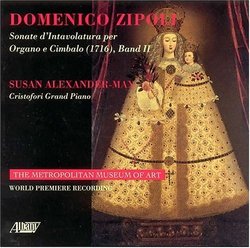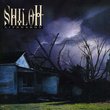The Sound of an Actual Cristofori Piano!
J Scott Morrison | Middlebury VT, USA | 08/07/2004
(5 out of 5 stars)
"Those of us who are piano lovers are aware that the piano was invented by Padua native Bartolomeo Cristofori (1655-1731) toward the end of the 17th century after he had moved to Florence. By the 1720s he had completed improvements that include most of the requisite elements for a modern piano. It is clear that Bach played and liked a copy of a Cristofori piano made by Silbermann (with an action identical to Cristofori's) on at least one occasion. Up until I heard this CD I had never heard a Cristofori (although I had seen this very instrument at the Metropolitan Museum of Art in New York City). I am thrilled to report that the sound of the instrument is unique and quite pleasing. One is very aware that the instrument can play 'piano e forte' ('soft and loud') unlike its predecessor, the harpsichord. This is because Cristofori substituted hammers for the plucking mechanism of the harpsichord, and dynamics can be varied by the force with which a key is struck. The actual sound of the strings is fairly similar to the harpsichord in that the treble is a bit weak, the bass stronger as one goes down the instrument's compass. Further, there is a mellow and, to me, entirely pleasing sound that I do not often associate with early pianos. (I have not always been satisfied with the various fortepianos I've heard, but perhaps that is because of the repertoire I've heard; generally it is music that I'd already associated with the sound of modern pianos. That is not the case with the music on this disc; Zipoli is a composer I'd never even heard of before.) There is no sustaining pedal, and in that respect the sound imitates that of the harpsichord. (Did you know that Mozart's piano didn't have pedals, either? He used a knee-activated mechanism for sustaining tones.) This particular Cristofori was built in 1720 and is one of only three extant pianofortes built by him. It sounds to be well-maintained and in excellent condition.
Domenico Zipoli (1688-1726) was a slightly younger contemporary of Bach, Handel and Scarlatti. Indeed, he studied briefly with the latter before he took priestly orders (just after writing this music) and was sent by the Jesuits to Argentina, then a province of Spain, where he died of tuberculosis at the age of 38. The works presented, written in 1716 (just four years before the present instrument was made ), are his 'Sonate d'Intavalotura per Organo o Cimbalo, Band II.' Band I was for organ only, but Band II (Book II) was written so that it could be played by either 'cembalo' (either harpsichord or 'piano e forte') or organ. This CD proclaims itself to be a world première recording, but I see that the music has been recorded at least once before by the redoubtable Sergio Vartolo on harpsichord. Band II consists of four Suites, each containing dance-based movements (corrente, gavotta, sarabanda, giga, allemanda, etc.), and a single-movement 'Partite.' The music has elements of Scarlatti (tripartite form, occasional virtuoso fingerwork) and Bach (primarily the Two-Part Inventions). There are memorable melodic elements throughout as well as infectious dance-rhythms. The counterpoint is a bit elementary (as in most of the Two-Part Inventions) but occasionally there are subtle and even surprising combinations, not to speak of startling and effective harmonic twists that keep one's expectations high. Overall, this is quite pleasant music. I certainly didn't lose interest throughout three complete traversals. I even found myself wondering if these pieces are published and easily available; I should think some of them would be fun for intermediate-level pianists to play.
The sensitive pianist here is Susan Alexander-Max who was previously unknown to me. I gather she specializes in music written for fortepiano; she has previous made recordings of music by Mozart, Hummel and Clementi.
I really enjoyed this CD and would recommend it to anyone curious to hear the sound of the Cristofori piano at the Met and to acquaint themselves with Zipoli's music.
TT=67:41
Scott Morrison"
Beautiful Music Played on a Rare Instrument
Brian J Hay | Sarnia, Ontario Canada | 04/22/2005
(5 out of 5 stars)
"Some of Zipoli's music has seen the light of day before but the instruments used for performances thus far have generally been harpsichords. J. Scott Morrison (a reviewer much more knowledgeable than myself) mentions one and apparently there was another done (in 1973) by Martha Goldstein where she played and recorded the B-Minor Gavotte as part of a collection of baroque keyboard works. Even the few people who have heard either of those recordings should look at this one. The sound of the fortepiano (particularly the early ones built by Cristofori) bears a marked similarity to that of a harpsichord but it is also obvious that it's an entirely different instrument. Its sound has the lightness of a harpsichord and strings can be heard clearly to be strings but the hammer mechanism of the fortepiano (versus the plucking action of the harpsichord) has a sound that's all its own. As well, it allows soloists control over phrasing, the ability to sustain notes and a dynamic range of sounds that harpsichordists can only yearn for.
The roots of Zipoli's music are obvious. His stylings are very similar to the keyboard works of Domenico Scarlatti and his musical phrases are similar in length. Many of his melodic ideas used run in a similar vein as well. In this his work is clearly music of its time but Zipoli had his own ideas about how they should be employed. He seems to have been partial to the use of rich and attractive melody as a means of holding listener attention. His melodic lines are lush and sumptuous regardless of whether they're written in a major or minor key. He holds clearly to an idea while running through it but varies it sharply with spacing, tempo changes and additions or subtractions from the original motifs. His music is less challenging than Scarlatti's and there aren't as many ideas used in each piece but he doesn't repeat anything to the point where it becomes tiresome either.
Pianist Susan Alexander-Max makes full use Zipoli's ideas and of the instrument's capabilities. Her touch is light and deft but she's more than willing to make full use of the volume the instrument offers as well. Her control is remarkable and her sense of musical phrasing is exquisite. The music often seems to be rolling back and forth like waves from a gentle sea or the rocking of a child's cradle. She's equally at home with any passage or tempo and always just seems to be rolling through the music as if she and it are inside one another. There's never a sense of listening to a Scarlatti rip-off and if this disc has an effect other than becoming a wonderful addition to any library of classical music it's to make me wish that Susan Alexander-Max would record some of Scarlatti's work as well. I suspect they would be a revelation to many listeners. She really is that good.
The placement of the microphone used for this recording is a bit unconventional. It's placed very close to the instrument and a lot of the noise from the area closest to the sound-board can be heard clearly. Noises from the instrument's mechanism, sounds of hammers brushing against strings and even echoes from within the cabinet itself are all clearly audible. This may be the best way to record these instruments though. The fortepiano has a delicate sound but its tones are rich to the point of being seductive. That quality is often lost in recordings but it comes through clearly here. Every note is bright, clear and warm. The notes from lowest octaves of these instruments have that beautiful "growl" unique to these instruments surrounding them. The placement given to the listener is unusual as well. Most recordings of solo keyboard instruments place the listener alongside the instrument. This one puts them pretty close to where they'd be if they were playing the instrument themselves. It's unusual and takes some getting used to but it's worth taking the time to do so.
The best thing to do with this recording is to just put it on the player, let it wash over and enjoy the surprises; there will be plenty of them. This is beautiful music and it's played and recorded beautifully on an instrument that has a sound not often heard anymore. This is a "must" for all lovers of baroque music with an Italian flavouring to it."


 Track Listings (6) - Disc #1
Track Listings (6) - Disc #1
